Phloem mass flow Study guides, Revision notes & Summaries
Looking for the best study guides, study notes and summaries about Phloem mass flow? On this page you'll find 48 study documents about Phloem mass flow.
Page 4 out of 48 results
Sort by
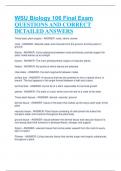
-
WSU Biology 106 Final Exam QUESTIONS AND CORRECT DETAILED ANSWERS
- Exam (elaborations) • 34 pages • 2024
-
- £8.12
- + learn more
WSU Biology 106 Final Exam QUESTIONS AND CORRECT DETAILED ANSWERS Three basic plant organs - ANSWER- roots, stems, leaves roots - ANSWER- Absorbs water and minerals from the ground. Anchors plant in ground. Stems - ANSWER- Carry substances between roots and leaves; provide support for plant; holds leaves up to sunlight leaves - ANSWER- The main photosynthetic organs of vascular plants. Nodes - ANSWER- the points at which leaves are attached internodes - ANSWER- the stem segments betwee...
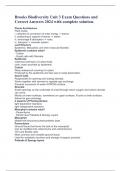
-
Brooks Biodiversity Unit 3 Exam Questions and Correct Answers 2024 with complete solution.
- Exam (elaborations) • 19 pages • 2024
-
- £11.38
- + learn more
Brooks Biodiversity Unit 3 Exam Questions and Correct Answers 2024 with complete solution. Plants Architecture Plant needs i. collection & conversion of solar energy -> leaves ii. positioning & support of leaves -> stems iii. anchorage & absorption -> roots iv. transport -> vascular system Leaf Structure Epidermis, Mesophyll, and Vein (Vascular Bundle) Epidermis contains what? - Cuticle - Guard cells with Stomata Epidermis outermost cell layer of a plant body cutin: (...
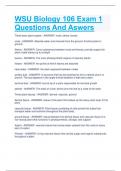
-
WSU Biology 106 Exam 1 Questions And Aswers
- Exam (elaborations) • 9 pages • 2024
-
- £6.90
- + learn more
WSU Biology 106 Exam 1 Questions And Aswers Three basic plant organs - ANSWER- roots, stems, leaves roots - ANSWER- Absorbs water and minerals from the ground. Anchors plant in ground. Stems - ANSWER- Carry substances between roots and leaves; provide support for plant; holds leaves up to sunlight leaves - ANSWER- The main photosynthetic organs of vascular plants. Nodes - ANSWER- the points at which leaves are attached internodes - ANSWER- the stem segments between nodes axillary bud -...
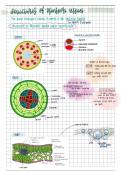
-
BIOLOGY - Transport In Plants
- Interview • 10 pages • 2023
-
- £5.68
- + learn more
The given document consist of completed notes with multiple diagrams and explanation to expand student's understanding in transportation of nutrients in plants. Important sentences and keywords are highlighted and there are some empty highlighted space for students to add their own extra notes. Syllabus covered: 1 draw plan diagrams of transverse sections of stems, roots and leaves of herbaceous dicotyledonous plants from microscope slides and photomicrographs 2 describe the distribution of ...
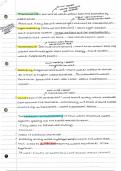
-
Unit 3-Mass transport in plants summary notes
- Summary • 6 pages • 2023
-
- £7.99
- + learn more
Handwritten notes on the following topics as part of the mass transport in plants section of unit 3: • Transpiration and factors affecting it • The cohesion-tension theory • Mass flow theory of translocation • Structure of phloem and xylem • Limiting water loss in plants • Investigating translocation Clearly written and easy to understand. Suitable for the AQA A-Level specification. Includes key marking points, scientific terminology and labelled pictures :)
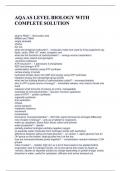
-
AQA AS LEVEL BIOLOGY WITH COMPLETE SOLUTION
- Exam (elaborations) • 15 pages • 2024
-
- £8.94
- + learn more
AQA AS LEVEL BIOLOGY WITH COMPLETE SOLUTION what is RNA? - ribonucleic acid MRNA and TRNA single stranded shorter AU CG what are biological molecules? - molecules made and used by living organisms eg. lipids, carbs, DNA, AT, water, inorganic ions what are the functions of carbohydrates? - -energy source (respiration) -energy store (starch and glycogen) -structure (cellulose) ATP structure? - 1 adenosine 3 phosphates ADP and energy= ATP condensation reaction using ATP synthase...
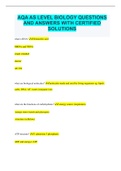
-
AQA AS LEVEL BIOLOGY QUESTIONS AND ANSWERS WITH CERTIFIED SOLUTIONS
- Exam (elaborations) • 51 pages • 2023
- Available in package deal
-
- £8.12
- + learn more
AQA AS LEVEL BIOLOGY QUESTIONS AND ANSWERS WITH CERTIFIED SOLUTIONS what is RNA? ribonucleic acid MRNA and TRNA single stranded shorter AU CG what are biological molecules? molecules made and used by living organisms eg. lipids, carbs, DNA, AT, water, inorganic ions what are the functions of carbohydrates? -energy source (respiration) -energy store (starch and glycogen) -structure (cellulose) ATP structure? 1 adenosine 3 phosphates ADP and energy= ATP condensation reaction using ATP synthase...
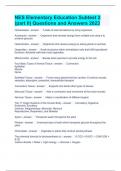
-
NES Elementary Education Subtest 2 (part II) Questions and Answers 2023
- Exam (elaborations) • 6 pages • 2023
- Available in package deal
-
- £12.60
- + learn more
NES Elementary Education Subtest 2 (part II) Questions and Answers 2023 Homeostasis A state of internal balance by living organisms Autotrophs Organisms that harness energy from sunlight and using it to produce glucose. Heterotrophs Organisms that receive energy by eating plants or animals. Organelles Small structures within animal/plant cells that fulfill specialized functions. Bacterial cells lack most organelles. Mitochondria Breaks down glucose to provide en...

-
DAT Biology Practice Exam Questions And Answers
- Exam (elaborations) • 1 pages • 2024
-
- £11.70
- + learn more
DAT Biology Practice Exam Questions Where is antidiuretic hormone stored in the body? A. Thyroid B. Pancreas C. Pineal gland D. Posterior pituitary E. Anterior pituitary - ANS D An otherwise healthy mother who consumes insufficient dietary vitamin B has four offspring that all produce insufficient growth hormone. What is the most likely connection? A. Epistatic link B. Polygenic link C. Common pleiotropic allele D. Epigenetic link E. No link, it was random - ANS D ...
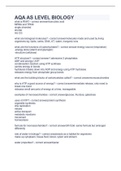
-
AQA AS LEVEL BIOLOGY 2023 with verified questions and answers
- Exam (elaborations) • 22 pages • 2023
-
- £8.94
- + learn more
what is RNA? ribonucleic acid MRNA and TRNA single stranded shorter AU CG what are biological molecules? molecules made and used by living organisms eg. lipids, carbs, DNA, AT, water, inorganic ions what are the functions of carbohydrates? -energy source (respiration) -energy store (starch and glycogen) -structure (cellulose) ATP structure? 1 adenosine 3 phosphates ADP and energy= ATP condensation reaction using ATP synthase carries energy in bonds hydrolysis b...



